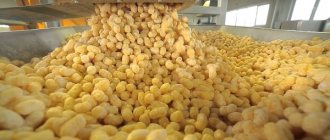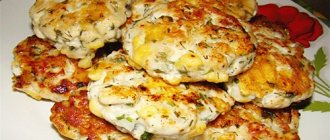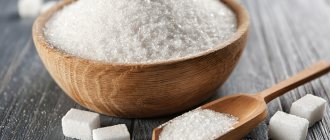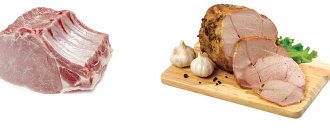What is caramel made from?
The recipe for classic caramel, which dates back to the 14th century, requires the use of only two main ingredients - water and sugar. The mixture was heated, poured into molds, and then cooled.
Modern caramels are also made from sugar, but in the production they additionally use invert syrup - a solution of sugar with citric acid, or caramel molasses. Such components help the sugar mass thicken faster. Food flavorings and dyes are added to candies, which also affect the nutritional value of the finished product.
Lollipops made with molasses contain:
- sucrose – 58%;
- glucose – 10%;
- polysaccharides (dextrin) – 20%;
- maltose – 7%;
- fructose – 3%.
The remaining 2% comes from water.
If invert sugar is used in production, then it occupies 20% of the volume, the remaining 80% is sucrose.
Caramel, whose calorie content on average reaches 360-380 kcal per 100 g, consists almost entirely of carbohydrates, the content of which fluctuates around 90 grams. There are practically no proteins or fats in the composition. The share of each nutrient in 100 g of product is insignificant - less than 1 gram.
Frequent use of lollipops is harmful to the body, as they can provoke:
- rapid weight gain;
- development of carious formations;
- provoke worsening of the condition in patients with diabetes or pancreatitis.
But caramel can also have a positive effect: consuming candy after physical activity promotes a surge of energy. This is due to the large amount of carbohydrates they contain.
Candy calorie table
| Candies | Proteins, g | Fats, g | Carbohydrates, g | Kcal per 100 g |
| Barberry | 96 | 370 | ||
| Bars | 11 | 30 | 53 | 514 |
| Squirrel | 9 | 33 | 53 | 538 |
| Cornflowers | 3 | 13 | 74 | 412 |
| Inspiration | 6 | 34 | 55 | 541 |
| evening call, evening Bell | 11 | 34 | 49 | 542 |
| Chocolate covered roast | 5 | 27 | 65 | 509 |
| Crow's feet | 2 | 7 | 88 | 409 |
| Duchess | 96 | 373 | ||
| Golden domes | 6 | 31 | 56 | 519 |
| Iris "Golden Key" | 3 | 8 | 82 | 395 |
| Iris "Kit-kis" | 3 | 12 | 77 | 416 |
| Lemon caramel | 94 | 362 | ||
| Mint caramel | 97 | 365 | ||
| Fruit and berry caramel | 93 | 360 | ||
| Strawberries and cream | 1 | 1 | 92 | 362 |
| Cranberries in sugar | 1 | 96 | 384 | |
| Cow | 6 | 33 | 55 | 541 |
| Little Red Riding Hood | 7 | 29 | 58 | 515 |
| Dried apricots in chocolate | 5 | 16 | 56 | 386 |
| Martin | 3 | 10 | 77 | 398 |
| Lollipops | 97 | 389 | ||
| Mask | 9 | 31 | 54 | 523 |
| Dream | 94 | 364 | ||
| Teddy Bear | 6 | 31 | 59 | 529 |
| Bear in the north | 8 | 32 | 55 | 529 |
| Muscovite | 3 | 9 | 79 | 394 |
| Autumn Waltz | 11 | 34 | 49 | 537 |
| Cockerel - golden comb | 7 | 36 | 57 | 530 |
| Cancerous cervixes | 2 | 8 | 87 | 411 |
| Raffaello | 9 | 48 | 37 | 615 |
| Daisies | 3 | 14 | 74 | 419 |
| Soufflé in chocolate | 2 | 18 | 58 | 406 |
| Truffle | 5 | 35 | 55 | 548 |
| Halva in chocolate | 15 | 33 | 44 | 528 |
| Citron | 1 | 18 | 82 | 389 |
| Prunes in chocolate | 5 | 20 | 50 | 390 |
Calorie content of different types of caramel
- The average number of calories per 100 grams of product is about 380 kcal.
- Based on this, the calorie content of 1 piece of caramel weighing about 6 g is 22.8 kcal. But this indicator is average: it all depends on the type of product itself.
Lollipops
- The brightly colored candies, so beloved by children and adults, consist almost entirely of sugar. This causes a high carbohydrate content: 100 g of sweets contains about 97.5 g.
- Therefore, 100 grams of candy contains a fairly large number of calories - about 390.
With liqueur
Approximately 358 calories.
It is worth remembering that the candy also contains an alcoholic component, which, when consumed in large quantities, can have a harmful effect on the body, especially when using antibiotics or following a diet.
Chocolate
If regular candies can still be consumed in small quantities without fear of instantly gaining extra pounds, then it is better to avoid candy with chocolate filling.
- When chocolate is added, the product contains 8 g of fat and 1.6 g of protein per 100 g.
- The increase in nutritional value is determined precisely by the addition of chocolate, the calorie content of which reaches 550 kcal per 100 g.
- However, its content in the filling is small, so the number of calories in the candy still does not reach the level of pure chocolate, but increases from an average of 380 kcal to 427 kcal.
Fruity
But caramel with fruit fillings is considered one of the lowest-calorie types among all similar products. Calorie content fluctuates around 372 kcal. This means that one candy weighing 6 grams contains approximately 22 kcal.
Lipstick
The calorie content of caramels with fondant filling fluctuates at 366 kcal, but the mark can drop to 358 kcal. This is due to the raw materials from which the filling is made. In the production of fudge, not only sugar is used, but also milk, which “dilutes” the carbohydrate component of the sweets. However, with its addition, other nutrients appear in caramel: fat in the amount of 4.6 g and 2.2 g of protein.
Various candies: calorie content
Let us remind you that the calorie content or energy value of a product is the amount of energy that is released in our body during the digestion process. Therefore, to burn extra calories, you need to expend more energy by doing physical activity. Or avoid excess calories in the body, for which there are calorie tables.
As already mentioned, the calorie content of sweets is high.
So, in Dirol candies there are 67 kcal, and in marmalade there are already 160 (per 100 g). Raffaello is very high in calories - as much as 615 kcal.
However, when counting the number of calories, it is more convenient to focus on the calorie content of 1 candy.
So, the calorie content of bird's milk candy is 444 kcal per 100 g, 53 kcal in 1 piece. The calorie content of cow candy is 364 kcal in 100 g, and 52 kcal in 1 piece.
Calories in chocolate candy (with cream filling) - approximately 523 per 100 g, almost 100 kcal in one piece
.
As for other sweets and candies, their calorie content can also be calculated individually:
- Raffaello 62 kcal;
- USSR ice cream 215 kcal;
- Teddy bear 80 kcal;
- Fruge with prunes 56 kcal;
- Meller (iris) 14 kcal;
- Skittles (dragée) 5 kcal;
- M&M's 3.33 kcal;
- Chupa Chups (candy) 57 kcal;
- Orbit without sugar (watermelon lollipop) 6 kcal;
- Kara-Kum 74.51 kcal;
- large Snickers (95g) 502 kcal;
- small Snickers (55g) 280 kcal;
- large Sars (73g) 331 kcal;
- large Picnic with walnuts (55 g) 261 kcal;
- small Milky Way (26 g) 118 kcal;
- large Nesquik (45 g) 219 kcal;
- small Nesquik (28 g) 140 kcal;
- grilled meat 60 kcal;
- Fruit and Nut chocolate bar with hazelnuts (90g) 500kcal, 1 slice (3.75g) 20.8kcal.
Properties of lollipops
How much do lollipops cost (average price for 1 kg)?
Moscow and Moscow region.
100 rub.
Candy lollipops or lollipops have been familiar to each of us since childhood. We think many people have cooked sugar cockerels on a stick at home. Candy canes are an incredibly easy-to-make type of confection made from sugar, corn syrup or molasses that are boiled and flavored, then poured into special molds, often with a stick.
Nowadays there is an unprecedented variety of candies. There are the following most popular types of sweet treats: candies, lollipops, caramel lollipops in paper wrappers, for example, “Barberry”. Montpensier or soft lollipops with a pronounced fruity and herbal aroma, pencil lollipops or long and oblong-shaped candies. In addition to sweet ones, there are candies with licorice or salty flavor.
Lollipops are used not only as a pleasant addition to tea drinking or as a favorite children's treat. In medicine, medicinal cough drops or restorative vitamin candies are often used. Lollipops are often used as a distraction product. The fact is that the process of sucking a treat forces our brain to fully concentrate on this action.
Therefore, lollipops are often offered in particularly nervous situations, for example, on an airplane or other form of transport. It is the method of eating sugar candies, and not the composition of the candies, that helps smokers cope with the desire to smoke. The candies contain simple ingredients such as sugar and water. This is a classic delicacy recipe.
Simple delicacies
Ordinary candies require creation according to a classic recipe. They contain water, sugar and citric acid (can be replaced with acetic acid). This composition can be expanded and transformed at your discretion, but water and sugar will always be the basis.
The cooking process involves the following steps:
- Mix the ingredients in an enamel bowl.
- Heat the dishes in water until the sugar is completely dissolved.
- Stir the food continuously, quietly reducing the heat.
- Leave the mixture to simmer until golden brown.
- The caramels will be ready when you drop a little syrup on the saucer and it begins to harden.
- Pour the syrup into pre-oiled molds.
- Insert toothpicks or chopsticks.
- Cool the products and remove from the molds.
Composition of lollipops
There are endless variations on the composition of the product. With the change in the main ingredients, the taste and consumer parameters of the confectionery product change, as well as the calorie content of the candies. The average calorie content of lollipops is 377 kcal. In addition to the high calorie content, the product contains a high carbohydrate content.
At home, you can make a lighter and more dietary product. And most importantly, homemade lollipops will be made without the use of stabilizers, flavoring additives and flavor enhancers, which confectionery manufacturers so often resort to. In addition to sugar, you can add milk, honey, chocolate, caramel, maple syrup or other fruit syrups to candies.
The history of candy goes back deep into the development and formation of humanity. Ancient people invented the first lollipops, although they were of natural origin. Sticks were used to collect honey so as not to lose a drop of the medicinal delicacy; people carefully licked the honey extraction tool. In Ancient China, Egypt and the Arab states, there were modern-style candies.
Until the middle of the last century, lollipops were considered souvenirs and piece goods that were made by hand. The unprecedented demand for candy after World War II forced confectionery manufacturers to expand their product range. Unfortunately, as often happens, during industrial production, the sweetness has lost most of its distinctive characteristics.
Benefit
The benefit of caramels is primarily that they lift your spirits. After all, they contain simple sugars. They are the ones who influence the body to begin creating and releasing an impressive amount of serotonin (a hormone that can give joy) into the blood. As a result, a person’s mood improves.
In addition, sugars are an excellent source of energy. Of course, a small lollipop won't charge you enough to run a 5K marathon. But it may well increase brain activity in order to cope with the task more efficiently and quickly.
All caramels have a bright smell and taste. Therefore, it is possible to freshen your breath, albeit for a short time. Homemade candies are often made from fruit syrups. Therefore, the components of juices enter the body, albeit in small volumes.
This is interesting! There are also unsweetened candies. Liquorice delicacies are especially popular in Europe. And in some tropical countries, sweets are filled with beetle larvae, which replace chewing gum. Unsweetened candies are considered healthier.
Harm to caramel
Of the harmful properties of caramel, it should be noted:
- sweets are saturated with sugar, which damages the integrity of tooth enamel and promotes the development of caries;
- caramel is excluded from the diet in case of diabetes, exacerbations of pancreatitis, cholecystitis;
- You will have to refuse the product if you are prone to edema, as well as with flatulence and bloating;
- due to their high calorie content and saturation with harmful carbohydrates, sweets are excluded from the diet if you are overweight, during a diet and losing weight;
- molasses and fruit acids of caramel contribute to dysfunction in the intestines;
- Some people have an individual intolerance to sweets, which can manifest itself in the form of rashes on the back, chest, and face.
Not everyone, but many sweet tooth lovers are periodically interested in how many calories are in chocolate candy. This is not surprising: most people with a sweet tooth are women who try to watch their weight.
Modern ladies do not need to know the calorie content of chocolates by heart: it is enough to have access to the Internet. The packaging usually also contains such information, but the calories there are given per 100 grams of product. If you are extremely careful about your diet, you may find information about the calorie content of a single candy useful.
Energy value
The calorie content of lollipops is 377 kcal. The energy value of the sweet is as follows:
- proteins – 0 g;
- carbohydrates – 97.5 g;
- fats – 0.1 g.
This is the average value of the food nutritional data. Depending on its origin, it may differ from the actual one.
It's hard to live without sweets!
It is especially difficult if you have already chosen your favorite type of candy and are constantly forced to contemplate it on store shelves at a time when you have just started following a certain diet.
Although it is worth noting that there are still diets during which you can occasionally make small deviations from the classic scenario and eat just a little sweets, however, even here you will have to take into account how many calories you have eaten and how much you can still eat.









